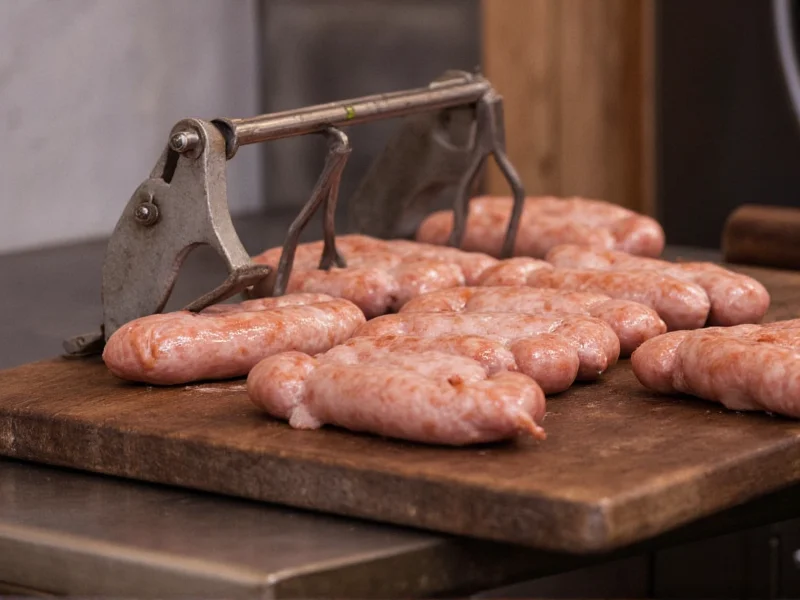Understanding the fundamentals of sausage making equipment helps both novice and experienced cooks produce high-quality homemade sausages. Whether you're exploring traditional methods or modern techniques, selecting the appropriate sausage maker significantly impacts your results. This comprehensive guide examines the mechanics, varieties, and practical applications of these essential kitchen tools.
How Sausage Makers Function
Sausage makers operate on a straightforward mechanical principle: forcing ground meat through a tube and into prepared casings. The core components include a hopper for holding the meat mixture, a plunger or auger system to create pressure, and interchangeable tubes that accommodate different casing sizes. Proper operation requires adequately prepared meat (typically chilled to 60°F or below), properly soaked natural or synthetic casings, and consistent pressure application.
Types of Sausage Making Equipment
Available sausage makers fall into three primary categories, each with distinct advantages depending on your needs and frequency of use:
| Type | Best For | Capacity | Price Range |
|---|---|---|---|
| Manual Hand-Crank | Occasional home use, traditional methods | 1-3 lbs per session | $30-$150 |
| Electric Home Models | Regular home sausage making | 3-10 lbs per session | $150-$400 |
| Commercial Units | Professional kitchens, frequent production | 10+ lbs per session | $500-$3000+ |
Key Features to Consider When Selecting Equipment
Choosing the right sausage stuffer requires evaluating several critical factors that impact both performance and longevity. Consider your typical batch sizes, available kitchen space, and desired frequency of use when making your selection. Home cooks who occasionally make sausage might prioritize compact storage and ease of cleaning, while serious enthusiasts may value higher capacity and durability.
Material construction significantly affects both performance and maintenance requirements. Stainless steel models offer superior durability and easier cleaning but come at a higher price point. High-quality food-grade plastics provide a more budget-friendly option while still meeting food safety standards. Look for models with smooth interior surfaces that prevent meat from sticking and ensure consistent flow.
Operating Your Sausage Maker Effectively
Proper technique dramatically improves results when using any sausage making equipment. Begin by ensuring your meat mixture is properly chilled (but not frozen) and your casings are thoroughly soaked according to manufacturer instructions. When loading the hopper, avoid overfilling to prevent messy overflow during operation.
For manual models, maintain steady, consistent pressure on the crank handle. Rushing the process can create air pockets or uneven filling. Electric models typically require monitoring the feed rate to match the machine's capacity. Regardless of model type, periodically check the emerging sausage for consistent thickness and adjust pressure as needed.
Maintenance and Care for Longevity
Proper cleaning and maintenance extend the life of your sausage making equipment significantly. Always disassemble components according to manufacturer instructions immediately after use, before meat residues can dry and harden. Most parts are dishwasher safe, but hand washing with warm, soapy water preserves moving parts longer.
Pay special attention to the auger and tube connections where meat particles can accumulate. Thorough drying before storage prevents rust and bacterial growth. For manual models, occasional lubrication of moving parts with food-safe mineral oil keeps operation smooth. Store components disassembled in a dry location to prevent warping or damage.
Benefits of Homemade Sausage Production
Using a quality sausage maker at home offers numerous advantages over store-bought alternatives. Complete ingredient control allows for customization of flavors, spice levels, and meat quality according to personal preferences and dietary needs. Home sausage making also proves more economical for regular consumers, with significant savings compared to premium store-bought varieties.
The process encourages culinary creativity through experimentation with unique flavor combinations and traditional recipes from various culinary traditions. Many home cooks find satisfaction in mastering this traditional food preservation technique while producing sausages free from unnecessary additives and preservatives common in commercial products.
What's the difference between a sausage stuffer and a sausage maker?
The terms are often used interchangeably, but technically a sausage stuffer specifically refers to the device that fills casings, while sausage maker can describe both the equipment and the person creating sausages. Most home kitchen equipment functions as a stuffer, handling the critical filling process.
Can I use a meat grinder attachment as a sausage maker?
Many meat grinders include sausage stuffing attachments that function adequately for occasional use. However, dedicated sausage makers typically provide more consistent pressure control and specialized features for optimal casing filling, especially for larger batches or delicate casings.
How do I prevent air pockets when using a sausage stuffer?
To minimize air pockets, ensure your meat mixture is properly chilled but not frozen, fill the hopper without overpacking, and maintain steady, consistent pressure during operation. Periodically pinch the emerging sausage to release trapped air, and avoid sudden stops and starts in the filling process.
What's the best way to clean a sausage maker after use?
Disassemble all components immediately after use while meat is still moist. Hand wash with warm, soapy water using a brush to reach crevices, or place dishwasher-safe parts on the top rack. Pay special attention to the auger and tube connections. Thoroughly dry all parts before storage to prevent rust and bacterial growth.
Can I make different sausage types with the same equipment?
Yes, quality sausage makers accommodate various sausage types through interchangeable tubes that match different casing sizes. From thin breakfast links to large diameter bratwurst or salami, simply change the appropriate tube attachment and adjust your technique for the specific meat mixture consistency.











 浙公网安备
33010002000092号
浙公网安备
33010002000092号 浙B2-20120091-4
浙B2-20120091-4